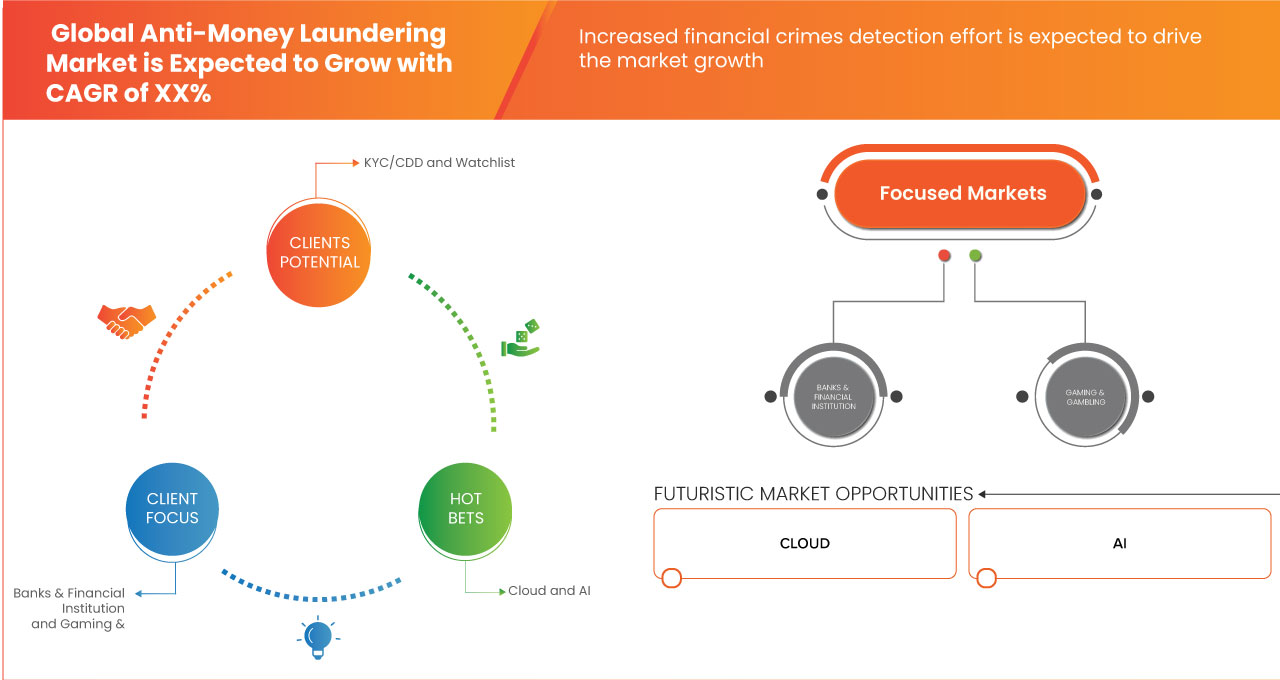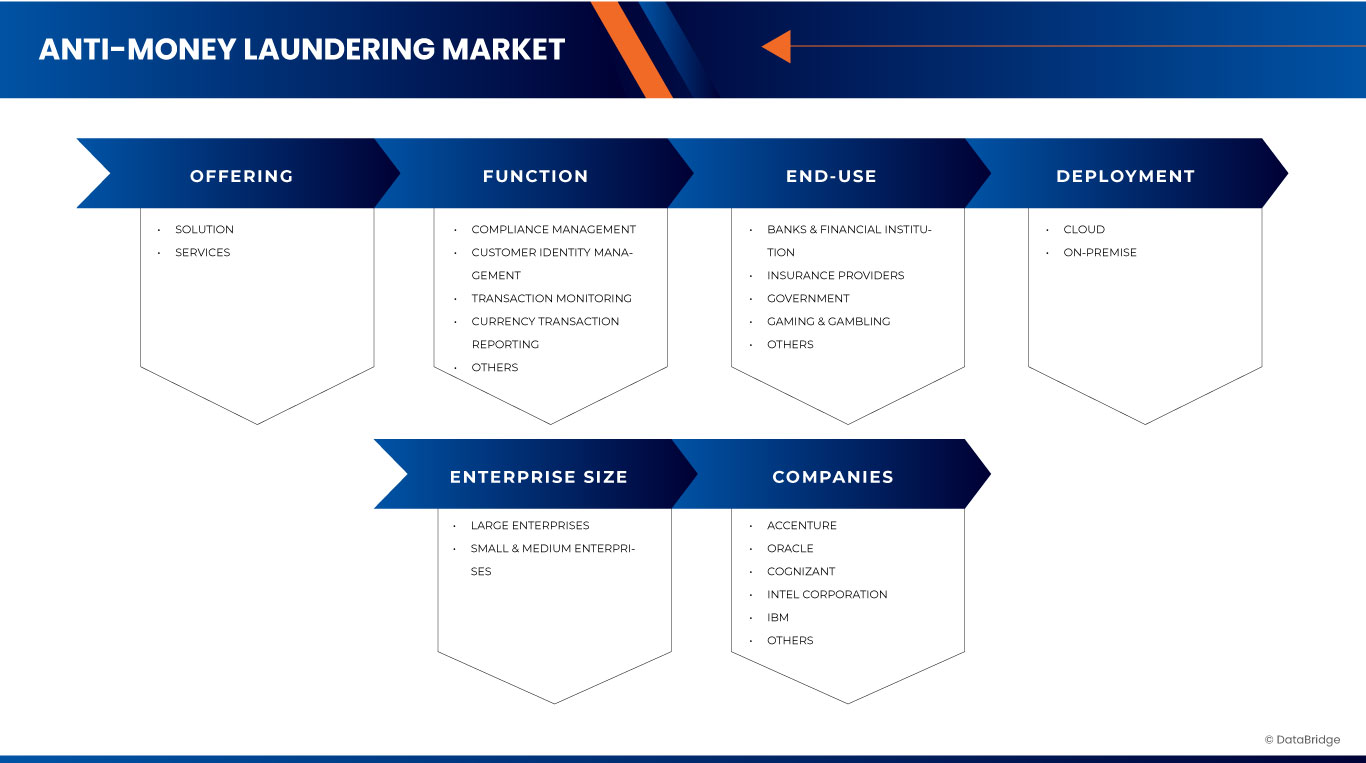世界のマネーロンダリング対策市場の規模、シェア、トレンド分析レポート
Market Size in USD Billion
CAGR :
% 
 USD
4.48 Billion
USD
13.56 Billion
2024
2032
USD
4.48 Billion
USD
13.56 Billion
2024
2032
| 2025 –2032 | |
| USD 4.48 Billion | |
| USD 13.56 Billion | |
|
|
|
>世界のマネーロンダリング対策市場のセグメンテーション、提供内容(ソリューションとサービス)、機能(コンプライアンス管理、顧客 ID 管理、取引監視、通貨取引報告など)、展開(クラウドとオンプレミス)、企業規模(大企業と中小企業)、最終用途(銀行と金融機関、保険会社、政府、ゲームとギャンブルなど) - 2031 年までの業界動向と予測。
世界のマネーロンダリング対策市場分析
世界のマネーロンダリング対策市場は、金融犯罪のパターンを評価する取引監視システムの需要増加により成長を遂げています。これは、テロ資金供与、詐欺、麻薬密売、賄賂、汚職、個人情報窃盗など、国の経済に重大な影響を及ぼす可能性のある金融犯罪を検出するためのさまざまなアプリケーションで使用できます。最近では、AMLソリューションは、保険会社、商業銀行、インターネット銀行、リテールバンキング、保険会社、住宅ローン会社など、さまざまな金融機関で人気が高まっています。さらに、ゲームおよびギャンブル業界、不動産業界、通貨交換(MSB)、決済業界、投資業界、世界中の政府機関など、さまざまな業界で人気が高まっています。
世界のマネーロンダリング対策市場規模
データブリッジ・マーケット・リサーチは、世界のマネーロンダリング対策市場は2023年の39億4,000万米ドルから2031年には118億1,000万米ドルに達し、2024年から2031年の予測期間に14.8%のCAGRで成長すると分析しています。
世界のマネーロンダリング対策市場の動向
「金融犯罪摘発の取り組み強化」
金融犯罪検出の取り組みが強化されたことで、マネーロンダリング対策 (AML) の監視が強化され、コンプライアンスの強化とシステム動向の監視に重点が置かれるようになりました。金融機関は、マネーロンダリングを示唆する疑わしい取引やパターンを特定するために、より厳格な手順を導入しています。これらの対策には、内部統制の強化、取引報告慣行の改善、規制機関との連携強化が含まれます。透明性と説明責任の向上を求める動きは、金融犯罪ネットワークを破壊し、違法な資金の流れを減らすことを目的としています。包括的な AML フレームワークを採用することで、組織はリスクを軽減し、金融システムの完全性を保護しようとしています。この積極的なアプローチは、金融犯罪と闘い、規制コンプライアンスを維持するという幅広い取り組みを反映しています。
レポートの範囲と世界のマネーロンダリング対策市場のセグメンテーション
|
レポートメトリック |
世界のマネーロンダリング対策市場の洞察 |
|
対象セグメント |
|
|
対象国 |
米国、カナダ、メキシコ、英国、ドイツ、フランス、イタリア、スペイン、ロシア、オランダ、スイス、ベルギー、トルコ、ルクセンブルク、その他のヨーロッパ諸国、中国、日本、インド、韓国、オーストラリア、シンガポール、マレーシア、タイ、インドネシア、フィリピン、台湾、ベトナム、その他のアジア太平洋諸国、ブラジル、アルゼンチン、その他の南米諸国、南アフリカ、サウジアラビア、エジプト、イスラエル、その他の中東およびアフリカ諸国 |
|
主要な市場プレーヤー |
BAE Systems、NICE、SAP SE、Open Text Corporation、ACI Worldwide、Accenture、Oracle、Cognizant、Intel Corporation、IBM など。 |
|
市場機会 |
|
|
付加価値データ |
データブリッジ市場調査チームがまとめた市場レポートには、市場価値、成長率、市場セグメント、地理的範囲、市場プレーヤー、市場シナリオなどの市場洞察に加えて、詳細な専門家分析、輸入/輸出分析、価格分析、生産消費分析、PESTLE分析が含まれています。 |
グローバルマネーロンダリング対策市場の定義
マネーロンダリング対策 (AML) ソリューションは、マネーロンダリング、テロ資金供与、詐欺、電子犯罪、賄賂や汚職、脱税、横領、情報セキュリティ、違法な国境を越えた取引など、国の経済に多大な影響を与え、国の評判を落とす可能性のあるものを検出し、機関に警告するために使用されます。AML は、マネーロンダリングや金融犯罪との戦いを表すために一般的に使用される用語です。マネーロンダリング対策 (AML) ソリューションは、金融犯罪の防止に役立つさまざまなポリシー、法律、規制に準拠しています。これらのガイドライン、ポリシー、法律は、AML ソリューションの機能強化を目的として、世界中のグローバルおよびローカルの規制当局によって制定されています。
世界のマネーロンダリング対策市場の動向
このセクションでは、市場の推進要因、利点、機会、制約、課題について理解します。これらについては、以下で詳しく説明します。
ドライバー
- 金融犯罪摘発の強化
金融犯罪検出の取り組みが強化されたことで、マネーロンダリング対策 (AML) の監視が強化され、コンプライアンスと監視システムの強化に重点が置かれるようになりました。金融機関は、マネーロンダリングを示唆する疑わしい取引やパターンを特定するために、より厳格な手順を導入しています。これらの対策には、内部統制の強化、取引報告慣行の改善、規制機関との連携強化が含まれます。透明性と説明責任の向上を求めることで、金融犯罪ネットワークを破壊し、違法な資金の流れを減らすことが目的です。包括的な AML フレームワークを採用することで、組織はリスクを軽減し、金融システムの完全性を保護しようとしています。
例えば、
- Informa PLCのブログによると、2024年8月、イスラエルのAI駆動型取引監視プロバイダーであるThetaRayがベルギーのフィンテックScreenaを買収した。同社は金融機関(FI)向けにAI搭載のAMLスクリーニングソリューションを提供している。この買収は、取引および顧客スクリーニングリスクの包括的なビューを提供するThetaRayの能力を強化することを目的としている。ギャンブル関連の違法行為を含む金融犯罪検出の取り組みの強化をサポートし、ThetaRayのクラウドベースのエンドツーエンドの金融犯罪検出プラットフォームを強化する。
- AMLに関する規制とコンプライアンスの強化
マネーロンダリング防止コンプライアンスプログラムとは、マネーロンダリングやテロ資金活動を防止、検出するために金融機関が従わなければならない一連の規制またはルールです。銀行や信用組合などの金融機関に対する金融犯罪は最近増加しています。2019年の金融詐欺事件は2018年から約50~60%増加しており、今後数年間で増加すると予想されています。ヨーロッパ全体の銀行が被った損失は非常に大きいです。
例えば、
- The Good Returnsが発表した記事によると、2024年7月、政府はマネーロンダリング対策(AML)規制を従来の金融機関だけでなく、不動産や仮想資産などの非金融セクターにも拡大した。この拡大は、高額取引と不透明性によるこれらのセクターの脆弱性に対処することを目的としていた。また、非遵守に対するより厳しい罰則も導入され、コンプライアンス文化が強化され、金銭的搾取のリスクが軽減された。ギャンブル会社にとって、これらの規制の強化はより堅牢なAMLフレームワークを促進し、誠実性を促進し、法的リスクを軽減する。
機会
- AMLにおける高度な分析の導入増加
高度な分析とは、洗練された技術とツールを使用してデータやコンテンツを分析する自律型または半自律型のシステムであり、従来のビジネス インテリジェンスとはまったく異なります。これらの分析では、システムが予測して推奨事項を生成するためのより詳細な分析が提供されます。AML ソリューションの高度な分析は、マネー ロンダリング、金融犯罪、個人情報の盗難、国境を越えた取引の検出に重要な役割を果たします。さらに、高度な分析は、高度な取引監視でも重要な役割を果たします。
国連薬物犯罪事務所(UNODC)によると、違法資金は年間2兆ドル相当に上る。2018年にバーゼルのマネーロンダリング対策(AML)が実施した別の調査では、2018年のランキング(129か国中83か国)の64%がリスクスコア5.0以上であり、マネーロンダリングとテロ資金供与の重大なリスクがあると大まかに分類できると指摘されている。
例えば、
- NDTV Profitが発表した記事によると、2024年5月、Pine Labs所有のSetuは、BFSIセクター向けにカスタマイズされたインド初の大規模言語モデル(LLM)アプリケーションをリリースした。このLLMは、広範なデータセットでトレーニングされており、テキストを認識して生成することができる。この高度な分析ツールの導入は、金融サービスにおけるテキスト処理と分析機能を改善することで、AML(マネーロンダリング対策)の取り組みを強化することを目的としている。Setuにとって、この動きは、最先端のAIをBFSIセクターに統合し、コンプライアンスとリスク管理のための高度なソリューションを提供するリーダーとしての地位を確立するものである。
- AMLソリューションの開発におけるAIとMLの統合
マネーロンダリングは、金融当局が阻止しようとしている非常に重要な金融問題となっています。調査によると、マネーロンダリングはヨーロッパのGDPの2〜5%に相当し、2兆ドルの純資産が洗浄されていると推定されています。個人情報の盗難や国境を越えた取引など、他にもさまざまな問題があります。
調査によると、2020年には個人情報盗難事件に関する苦情が140万件登録されました。2020年の欧州全域での国境を越えた取引は、約23.21兆米ドルと推定されています。すべての金融犯罪は、AMLソリューションが脆弱であることと、規制当局が定めたガイドラインに従うことをためらうことが原因で発生しています。Fenergoの調査によると、規制当局/機関は2019年に銀行に記録的な100億米ドル相当の罰金を科しました。また、罰金の60.5%は銀行がマネーロンダリング防止規則に違反したことによるものであると指摘されています。
例えば、
- 3月に、ACI Worldwide, Inc.は金融機関向けのACI不正スコアリングの立ち上げを発表しました。これは、次世代の機械学習機能を提供するために立ち上げられたプラットフォームです。この立ち上げにより、同社は顧客ベース向けのソリューションポートフォリオを拡大することができます。このソリューションは、金融機関が支払いサーバーを保護するのに役立ちます。
制約/課題
- 顧客データ監視におけるプライバシーの懸念
The rise in online gambling platforms has heightened privacy concerns regarding customer data monitoring. As operators implement advanced anti-money laundering (AML) measures, they collect and analyse extensive personal information to detect suspicious activities. This scrutiny raises significant privacy issues, as users’ sensitive data is increasingly subject to detailed tracking and examination. Balancing effective fraud prevention with robust data protection is crucial, as excessive monitoring can lead to breaches of privacy and erode customer trust.
For instance,
- In October 2023, according to the article published by Mondaq Ltd., India's Digital Personal Data Protection Act, 2023, introduced new privacy regulations impacting the online gaming industry. The act emphasized stricter data protection measures, requiring gaming platforms to ensure explicit consent for data processing, provide rights to data access and correction, and enforce robust security practices. The regulations also addressed concerns related to targeted marketing, especially towards minors, and set higher compliance standards for platforms handling large volumes of user data
Deploying AML Software is Expensive
According to the survey conducted by the Government Accountability Office (GAO). U.K. banks spent between 0.4% and 2.4% of their total 2018 operating expenses on anti-money laundering software. Banks in the survey spent an average of USD 15 per new account on due diligence requirements, even though the actual cost ranged from USD 5 to USD 44 depending on the type of bank. It was observed that banks spend the most on CDD, 29%, and reporting costs of 28% on average. In comparison, 18% was associated with training, testing, internal controls, software, and third-party costs, which accounted for 17% of AML solutions on average. In Europe, a survey conducted by LexisNexis risk solution in 2019 stated the true cost of anti-money laundering (AML) software is very high in European countries as the demand for the product is high.
For instance,
- In September 2023, according to the article published by The Investopedia, HSBC was fined USD 1.9 billion for severe lapses in its anti-money laundering (AML) controls, notably for laundering money for Mexican drug cartels. The scandal highlighted weaknesses in HSBC's compliance mechanisms and led to the imposition of additional $665 million in civil penalties. This case underscores the high cost of deploying effective AML software and compliance measures in banking. Investing in advanced AML solutions helps prevent costly penalties and maintains regulatory compliance, benefiting financial institutions by reducing legal risks and enhancing operational integrity
Global Anti-Money Laundering Market Scope
The global anti-money laundering market is segmented into five notable segments on the basis of the offering, function, deployment, enterprise size, and end use. The growth amongst these segments will help you analyse meagre growth segments in the industries and provide the users with a valuable market overview and market insights to help them make strategic decisions for identifying core market applications.
By Offering
- Solution
- KYC/CDD and Watchlist
- Transaction Screening and Monitoring
- Case Management
- Regulatory Reporting
- Services
- Type
- Professional Service
- Managed Service
- Type
- Services
- Type
- Integration
- Support and Maintenance
- Training and Consulting
- Type
By Function
- Supervisory Compliance Management
- Currency Transaction Reporting
- Customer Identity Management
- Transaction Monitoring
By Deployment
- Cloud
- On-Premise
By Enterprise Size
- Large Enterprises
- Small & Medium-Sized Enterprises
By End Use
- Banks & Financial Institutions
- Insurance Providers
- Gaming & Gambling
- Gambling Type
- Casino
- Type
- Live Casinos
- Poker
- Blackjack
- Baccarat
- Slots
- Others
- Type
- Casino
- Application
- Live Entertainment/Online
- Type
- Hotels
- Multiple Dining Options
- Others
- Type
- Offline/Land Based
- Type
- Mobile
- Desktop
- Type
- Sports Betting
- Type
- Football
- E-sports
- Horse racing
- Others
- Type
- Lottery
- Bingo
- Raffles/Pools
- Live Entertainment/Online
- Gambling Type
- Government
- Others
Global Anti-Money Laundering Market Regional Analysis
The global anti-money laundering market is segmented five notable segments on the basis of the offering, function, deployment, enterprise size, and end Use.
The countries covered in the global anti-money laundering market report are U.S., Canada, and Mexico, U.K., Germany, France, Italy, Spain, Russia, Netherlands, Switzerland, Belgium, Turkey, Luxembourg, rest of Europe, China, Japan, India, South Korea, Australia, Singapore, Malaysia, Thailand, Indonesia, Philippines, Taiwan, Vietnam, and rest of Asia-Pacific, Brazil, Argentina, rest of South America, South Africa, Saudi Arabia, Egypt, Israel, and rest of Middle East and Africa.
Europe region is expected to dominate and fastest growing region in the market due to its robust industrial base, stringent quality standards, and strong presence in various sectors.
The country section of the report also provides individual market impacting factors and changes in market regulation that impact the current and future trends of the market. Data points like down-stream and upstream value chain analysis, technical trends and porter's five forces analysis, case studies are some of the pointers used to forecast the market scenario for individual countries. Also, the presence and availability of brands and their challenges faced due to large or scarce competition from local and domestic brands, impact of domestic tariffs and trade routes are considered while providing forecast analysis of the country data.
Global Anti-Money Laundering Market Share
Global anti-money laundering market competitive landscape provides details of the competitor. Details included are company overview, company financials, revenue generated, market potential, investment in research and development, new market initiatives, production sites and facilities, production capacities, company strengths and weaknesses, product launch, product width and breadth, application dominance. The above data points provided are only related to the companies' focus.
The global anti-money laundering market leaders operating in the market are
- NICE (Israel)
- IBM (U.S.)
- sanctions.io (U.S.)
- Intel Corporation (U.S.)
- Oracle (U.S.)
- SAP SE (Germany)
- Accenture (U.S.)
- Experian Information Solution
- Inc. (Ireland)
- Open Text Corporation (Canada)
- BAE Systems (U.K.)
- SAS Institute Inc (U.S.)
- ACI Worldwide (U.S.)
- Cognizant (U.S.)
- Trulioo (Canada)
- Temenos Headquarters SA (Switzerland)
- WorkFusion, Inc, (U.S.)
- Vixio Regulatory Intelligence (England)
Latest Developments in Global Anti-Money Laundering Market
- In September 2023, IBM announced that its Payments Center joined the Swift Partner Programme, creating new collaboration opportunities with over 11,000 Swift members worldwide. This partnership allowed IBM to offer enhanced payment solutions and end-to-end cloud-based Swift connectivity, reducing the need for clients to manage Swift hardware and software. The collaboration helped financial institutions modernize payment platforms, access AI technologies, and improve efficiency without high development and compliance costs
- In April 2024, Oracle introduced the Financial Services Compliance Agent, an AI-powered cloud service designed to help banks mitigate anti-money laundering (AML) risks. This service allows banks to conduct cost-effective scenario testing to adjust controls, identify suspicious transactions, and enhance compliance. It also helps banks assess and optimize transaction monitoring systems, evaluate new product risks, and proactively address high-risk typologies. This solution aims to reduce compliance costs and improve the effectiveness of AML programs
- In January, Oracle highlighted its comprehensive cloud solutions for banks through Oracle Financial Services. The company emphasized that banks are increasingly adopting cloud services driven by AI and ML advancements. Oracle provides a full suite of fintech solutions that are cloud-ready, scalable, and secure, offering banks a single vendor solution without the need for multiple fintech partnerships. Oracle's platform supports over 3,000 microservices and open APIs, helping banks transition from legacy systems and stay competitive
- 9月、オラクルとQuantifindは、マネーロンダリング対策(AML)プロセスを強化するための戦略的提携を発表しました。調査、顧客デューデリジェンス、アラート管理のためのQuantifindのSaaSソリューションが、オラクルの金融犯罪およびコンプライアンス管理プラットフォームと統合されました。このパートナーシップは、AMLの効率を最大30%向上させ、高度なAIと機械学習でワークフローを合理化することを目指していました。この統合により、オラクルのクライアントは包括的なデータにアクセスし、統合プラットフォームを通じてAMLコンプライアンス機能を強化できるようになりました。
SKU-
世界初のマーケットインテリジェンスクラウドに関するレポートにオンラインでアクセスする
- インタラクティブなデータ分析ダッシュボード
- 成長の可能性が高い機会のための企業分析ダッシュボード
- カスタマイズとクエリのためのリサーチアナリストアクセス
- インタラクティブなダッシュボードによる競合分析
- 最新ニュース、更新情報、トレンド分析
- 包括的な競合追跡のためのベンチマーク分析のパワーを活用
調査方法
データ収集と基準年分析は、大規模なサンプル サイズのデータ収集モジュールを使用して行われます。この段階では、さまざまなソースと戦略を通じて市場情報または関連データを取得します。過去に取得したすべてのデータを事前に調査および計画することも含まれます。また、さまざまな情報ソース間で見られる情報の不一致の調査も含まれます。市場データは、市場統計モデルと一貫性モデルを使用して分析および推定されます。また、市場シェア分析と主要トレンド分析は、市場レポートの主要な成功要因です。詳細については、アナリストへの電話をリクエストするか、お問い合わせをドロップダウンしてください。
DBMR 調査チームが使用する主要な調査方法は、データ マイニング、データ変数が市場に与える影響の分析、および一次 (業界の専門家) 検証を含むデータ三角測量です。データ モデルには、ベンダー ポジショニング グリッド、市場タイムライン分析、市場概要とガイド、企業ポジショニング グリッド、特許分析、価格分析、企業市場シェア分析、測定基準、グローバルと地域、ベンダー シェア分析が含まれます。調査方法について詳しくは、お問い合わせフォームから当社の業界専門家にご相談ください。
カスタマイズ可能
Data Bridge Market Research は、高度な形成的調査のリーダーです。当社は、既存および新規のお客様に、お客様の目標に合致し、それに適したデータと分析を提供することに誇りを持っています。レポートは、対象ブランドの価格動向分析、追加国の市場理解 (国のリストをお問い合わせください)、臨床試験結果データ、文献レビュー、リファービッシュ市場および製品ベース分析を含めるようにカスタマイズできます。対象競合他社の市場分析は、技術ベースの分析から市場ポートフォリオ戦略まで分析できます。必要な競合他社のデータを、必要な形式とデータ スタイルでいくつでも追加できます。当社のアナリスト チームは、粗い生の Excel ファイル ピボット テーブル (ファクト ブック) でデータを提供したり、レポートで利用可能なデータ セットからプレゼンテーションを作成するお手伝いをしたりすることもできます。




















